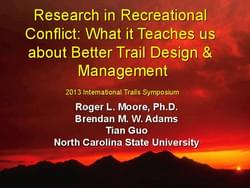




What it Teaches Us About Better Trail Design and Management
The purpose of this presentation is to provide an easy to understand and practical overview of past and current research related to trail conflict in a way that enables trail professionals to improve trail design and trail management.
by Roger Moore, Associate Professor, North Carolina State University, Brendan Adams, Graduate Student, North Carolina State University

The purpose of this presentation is to provide an easy to understand and practical overview of past and current research related to trail conflict in a way that enables trail professionals to improve trail design and trail management. This session will begin with a presentation that introduces a social science-based “behavioral approach” to help understand why trail users do what they do. It will then move into an overview of the research related to trail conflict with an emphasis on what things influence the types and levels of problems that can occur and what principles and practical guidance we can draw. Most importantly, the session will engage and involve those present in applying the principles and knowledge they have learned. We will do this by selecting several actual trail conflict situations the participants are facing in their home jurisdictions and working in small teams (hopefully including people in each team who participate in the trail activities in question) to develop integrated approaches to addressing those conflicts that could actually be implemented. Teams will report out on their proposed approaches and receive feedback from the full group.
posted Apr 17, 2024
This report summarizes guidance and best practices to create safer bicycle facilities and connect them into networks that allow more people to safely bike to more places within and throughout communities.
Setting Speed Limits for Health and Safety
posted Apr 17, 2024
This mini-report on setting speed limits shows the current framework for speed limit policies through a review of state laws that set speed limits.
posted Nov 14, 2023
These case studies reveal a number of lessons learned that will be valuable in future winter travel management planning efforts.
TRAILS SAFE PASSING PLAN: STOP, SPEAK, and STAND BACK
posted Feb 14, 2023
Horses are prey animals and naturally can be afraid of unfamiliar people and objects. Horses have natural "flight“ survival instincts and prefer to move their feet towards an exit route. Therefore, people with horses should pass at a walk while other trail users remain STOPPED until passed.
854 views • posted 02/19/2018